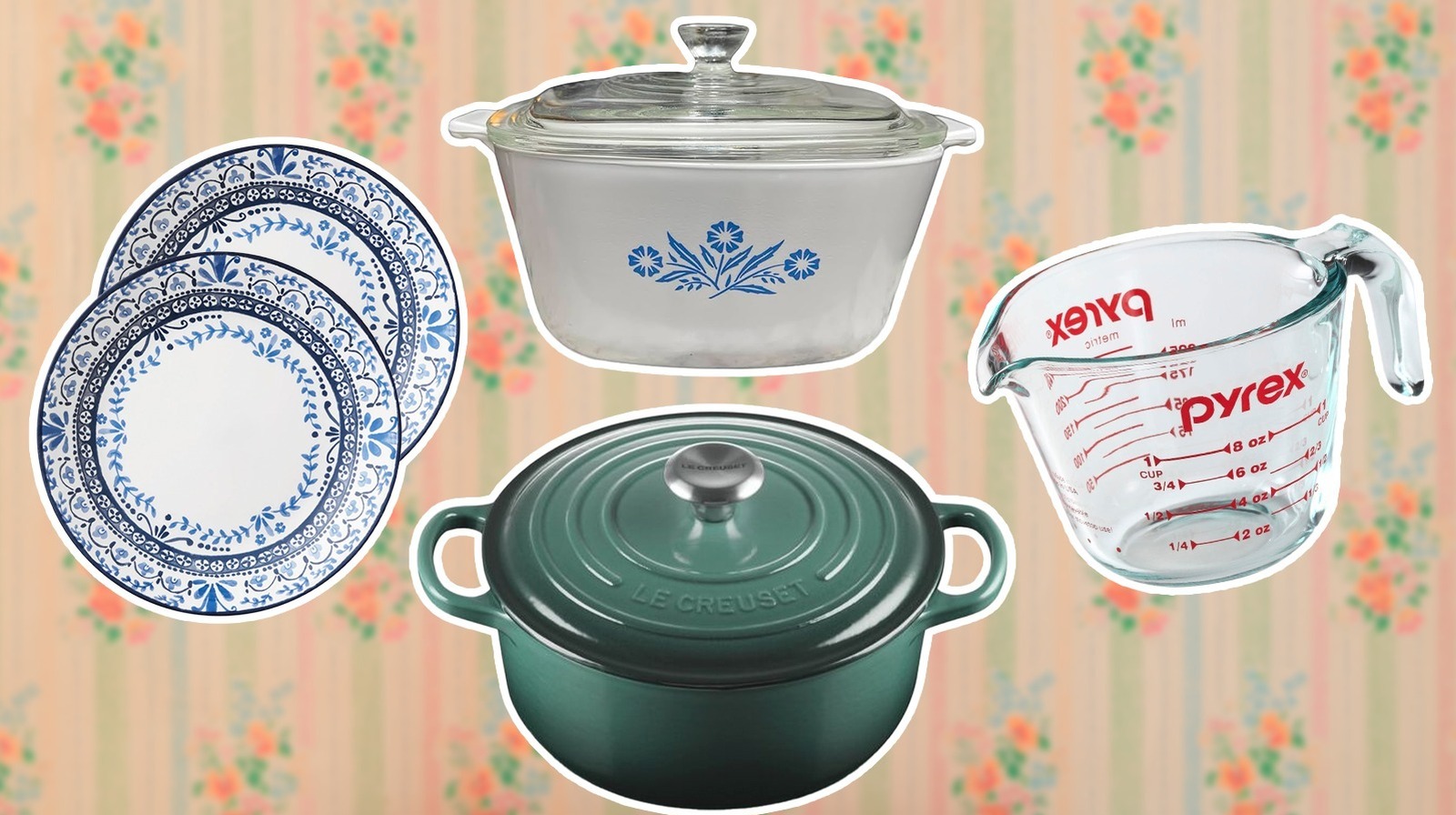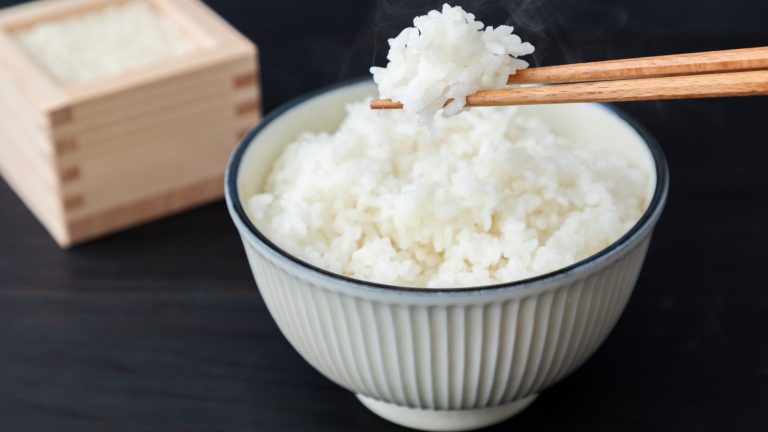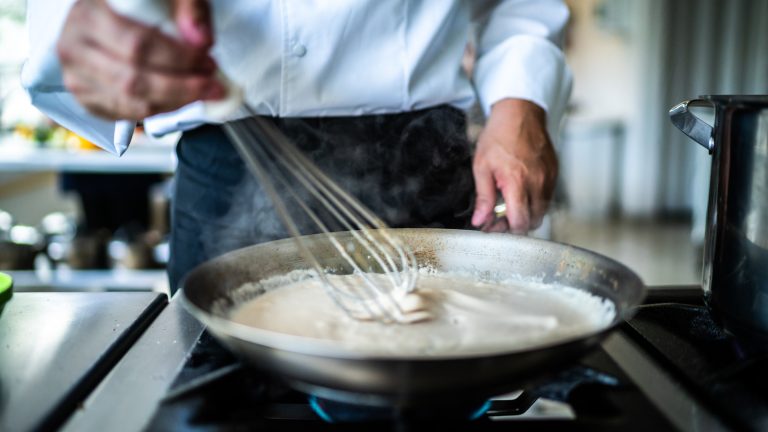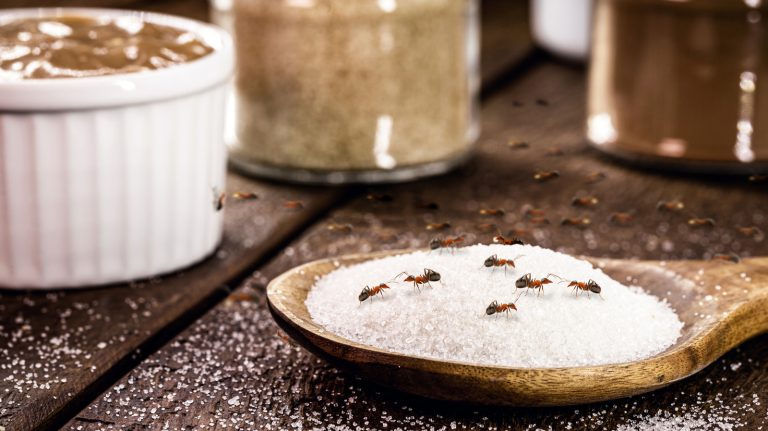Thrift stores can be a great place to stock your kitchen if you know what you’re looking for. It’s even better if you stumble upon a thrift store that doesn’t know the value of what they have. You may already have a few brands you like to keep your eyes open for, but there are even more that might pique your interest once you know what makes them so special. You never know when there might be an unassuming gem lurking right in front of your eyes.
There are a variety of vintage kitchen brands that have stood the test of time in categories ranging from cookware and appliances to dishes and glasses. Once you’re familiar with them, they’ll start sounding their siren’s call to you from across the store. Some brands have been making products for centuries or decades, while others are firmly lodged in the past, making them extra special. The fact that these products are still in good condition is a testament to their craftsmanship. Once you have an idea of which brands to look for while thrifting, the hunt is on.
Libbey
The oldest vintage kitchen brand on our list is Libbey. The company began making glass kitchen and dining products in Cambridge, Massachusetts, in 1818 as The New England Glass Company. The glasses are made with high-brilliance soda lime glass, which is durable, doesn’t have any harmful heavy metal ingredients like lead, and is crafted to last a lifetime.
Beyond its durability factor, Libbey is collectible and has lots of interesting patterns from which to choose. There’s something for everyone from mid-century patterns that often include gold and silver leafing to novelty and holiday glasses. There are also Libbey glasses for special purposes like sipping bourbon and whiskey.
You can thrift singular Libbey glasses for just a couple of dollars each, which can be fun if you just like to collect interesting drinking glasses or are trying to complete a collection. Although we’ve also encountered some rarer sets that are hundreds or thousands of dollars.
Griswold
Griswold cast iron cookware is always a great thrift store find. Griswold Manufacturing Company got its start making metal hinges in 1865 but switched over to making iron cookware in the following decades. By the 1880s, it was making iron products like waffle irons and skillets. The brand has continued under different parent company names, with American Culinary making the brand today and considering itself the oldest crafter of cookware in the U.S. So, acquiring vintage Griswold is like owning a piece of U.S. history.
Griswold iron cookware is known for having near-flawless, smooth surfaces created through tumbling and grinding the surfaces. These extremely smooth surfaces keep their non-stick seasoning better than brands with rougher surfaces.
Some rare early Griswold pieces go for hundreds of dollars, although you can certainly find ones for under $10. The ones with the word “Erie” on the bottom are the oldest and most prized. Ultimately, the markings on the bottom of Griswold don’t matter if you’re just seeking a quality product, but finding it at thrift-store prices is exciting.
Lodge
Lodge followed Griswold into the cast iron cookware scene in 1896. Like Griswold, Lodge had incredibly smooth surfaces in its early iron pans. However, modern ones have a rougher, more pitted surface since the company no longer uses machines to make its surfaces smooth as it once did. So, if you’re thrifting, finding one from before the 1960s may be ideal.
Lodge cookware has had decades of fans, like Alton Brown. The older, smoother Lodge pans maintain a more non-stick surface than newer pans, until they’re older, worn a bit, and well-seasoned. So, if you want an iron pan that’s going to make you happy from moment one, an older, smoother vintage one is going to be less frustrating.
It’s possible to find new and older pieces of the same size for around the same price. However, some of the earliest Lodge pans with smooth surfaces can be worth a couple of hundred dollars.
Cathrineholm
When you spy the classic lotus print on a piece of Cathrineholm in a thrift shop, you’re likely to gravitate toward it, whether you’re a mid-century modern fan or not. Cathrineholm is one of the few brands on our list that is no longer in production, making these beautiful kitchenware pieces all the more desirable. Cathrineholm was a Norwegian factory that started out in 1827 working with iron before switching to its now-famed enamel products around 1907. The classic lotus design first arrived in the 1960s, with the factory closing in 1972.
The company polished its enamel to help prevent chipping and advertised that its dishes were harder than steel. The fact that so many are still in amazing shape is a testament to this claim. They come in a variety of colors and prints to suit nearly any kitchen, with products including tea kettles, coffee pots, cookware, fondue sets, warming sets, and other kitchen items.
You can find lotus and other styles for reasonable prices in the $20 to $30 range. Although we’ve seen some larger sets go for hundreds or over $1,000. So, you never know when the one find might be fairly valuable.
Pyrex
There are two big reasons vintage Pyrex is among the most sought-after thrift store finds. One is that the older dishes are a lot more sturdy. The other reason is that they come in a variety of collectible colors and patterns.
Corning began its long history in 1879 as the creator of the glass for Thomas Edison’s new light bulbs. In 1912, it started creating heat-resistant glass for railroad signal lanterns that could endure temperature changes. One of the physicists working for Corning in 1913 tried turning the glass into cookware, making its first temperature-change-resistant borosilicate Pyrex glassware in 1915. However, Pyrex from the 1950s onward has been soda lime glassware, which users find more likely to shatter with temperature changes, like putting a dish full of frozen food into a preheated oven. To tell if you’ve found the original Pyrex or not, you’ll want to look to make sure the logo reads “PYREX” rather than “Pyrex.”
Pyrex has lots of highly sought-after patterns as well. More rare finds and patterns sell for multiple thousands of dollars. However, nesting bowls and casserole sets with lids are always great finds and more likely to be reasonably priced. Or you might just have a favorite print you want to find.
KitchenAid
The very first KitchenAid mixer — Model H-5 — came out in 1919, with attachments built to make everything you do in the kitchen all that much easier. It wasn’t until 1993 that the brand expanded to include other kitchen items, like food processors and hand mixers. While KitchenAid still sells one of the best stand mixers, the older they are, the more valuable they can sometimes be.
Those early Hobart H-5 kitchen mixers can sell for multiple thousands of dollars in excellent used condition, even without tons of extra attachments. Sometimes the value comes from being heavy-duty commercial versions, while other times, the value might be in the color or style.
Something else KitchenAid fans like is that all the attachments fit every model, no matter the age. So, you could even turn your newer KitchenAid into a pea sheller or coffee grinder with the right vintage attachment from the thrift store.
Alessi
Alessi had its start in Italy in 1921, under the name of Fratelli Alessi Omegna, making high-quality metal home objects. What will likely strike you most if you encounter an Alessi kitchen product while thrifting is how stylish the pieces are. Whether serious or whimsical, Alessi’s kitchen items are works of art, being created from the minds of artists, architects, and other designers.
In the 1970s, the company started using artists like Salvador Dali to help design its kitchenware, and the company began its Tea & Coffee Piazza project to create stylish tea and coffee sets in the 1980s. One of its most iconic pieces, Michael Grave’s bird kettle, made its debut in 1985. Another famous piece you can’t possibly leave at the thrift store is Philip Stark’s Juicy Salif, a citrus squeezer that looks like a three-legged arachnid alien structure from a sci-fi movie. While we’ve seen some items go for multiple hundreds of dollars, there are certainly much more reasonably priced items out there, like $30 fruit bowls.
Le Creuset
The French company Le Creuset has been making cookware for over 100 years, starting in 1925. Their iron enameled cookware is so well-crafted that they’ve become heirloom kitchenware pieces, handed down from generation to generation.
You probably won’t miss a piece of Le Creuset cookware lurking on the shelves of a thrift store since they come in such vibrant colors. While a vintage Le Creuset Dutch oven is the ultimate find, you might also encounter other items like loaf pans or ramekins.
While thrifting, vintage Le Creuset fans look for older pieces that are cheaper than new, pieces to match their color of choice, or rare pieces. For example, a 1950s skillet in the original “volcanic flame” color could be worth multiple thousands of dollars. However, another reason older pieces are sought after is that time smoothes and rounds the sharp edges and gives the enamel more of a matte finish. Just be sure to watch for chips and deep scratches before snatching up a vintage piece.
Fiestaware
Fiesta, the company that makes Fiestaware, got its start in the 1840s in Liverpool, England. It wasn’t until 1936 that Fiestaware made its debut in the U.S., with hopes that its bright, festive colors would bring a little cheer to the tables of the Great Depression.
One nice thing about collecting durable Fiestaware is that pieces of the same color match, no matter which year they’re from. Plus, you can choose one color, shades of the same color, or multiple colors to match your tastes. The color you want greatly affects the cost of the vintage pieces. While you can find many pieces for just a couple of dollars each, we’ve also seen rarer pieces going for multiple thousands of dollars, and medium green pieces are almost always the most expensive.
We do want to caution against thrifting vintage Fiestaware from before 1972, when the company sometimes used radioactive uranium oxide in its glaze. The radiation quantities can be high enough to expose anyone in the room to some level of radiation. Vintage Fiestaware has a lowercase “F” in the logo, with ones made before 1986 not having a loop at the top of the “F.”
Revere Ware
While the company originated with John Revere when he began supplying copper to the U.S. government in 1803, Revere Copper and Brass didn’t evolve to start making its famous Revere Ware until 1938. Revere Ware pots and pans are made of durable stainless steel, have a copper bottom to help with heat distribution, and have stay-cool and oven-safe handles up to 350 degrees Fahrenheit. However, the older ones are much more desirable than the newer ones.
The Revere Ware pieces you really want to find are the ones made before 1968, when the company used much thicker layers of copper and stainless steel. Probably the easiest way to know if you’ve found the older version is if you see the words “Made Under Process Patent” or “Pat. Pending” on the bottom of the pan. If your thrift store Revere Ware find isn’t in the best of shape, you can find replacement parts and clean it up to be nearly as good as new.
Fire King
Anchor Hocking (previously Hocking Glass Company) put out Fire King glassware products between 1940 and 1976. The fact that you can still find them gives you an idea of how durable the bowls, dinnerware, restaurant ware, and coffee mugs were. It was another brand made to not shatter when going between hot and cold temperatures. However, the brand also had nice designs.
Its Restaurant Ware line was known as Jadeite and came in a pale green color, which is common in thrift stores. Jadeite first gained popularity during the Great Depression and remains popular today. We’ve seen rarer Jadeite sets like Swedish modern bowls go for well over $1,000 for a four-piece set. However, there are plenty of pieces for around $5, like Jadeite saucers or the “Good Morning” mugs that came free with McDonald’s breakfasts in 1976. There are still other patterns to look for. One of the rarest patterns is the Philbe one, which is the transparent blue glass color in its Rainbow line. And we’re partial to the Kimberly Diamond cups.
Tupperware
There probably weren’t many houses in the last half of the 20th century that didn’t have a few pieces of Tupperware in the cupboards. The brand got its start in 1946, creating reusable plastic storage containers with air-tight “burp-seal” lids for storage and serving. Tupperware parties became all the rage, offering a chance to try out some of these containers with all your friends and make a little money on the side.
Tupperware represents a bit of nostalgia when you find some in a thrift store. However, the containers are also handy and colorful. While some vintage Tupperware sets like matching canister sets might go for several hundred dollars, there are plenty of reasonably priced Tupperware items to keep watch for, too, such as stacking canisters and nesting bowls. However, you’ll want to keep in mind that anything made before 2010 isn’t food safe since the company didn’t remove BPA until that year. When in doubt, check the plastic number on the bottom of the container, looking for the numbers 1, 2, or 5 and avoiding 7 if you plan to use them with food.
CorningWare
Corning, the same company that makes Pyrex, accidentally developed what would become CorningWare in 1952. Stanley Donald Stookey created the material that became CorningWare when he accidentally heated FotoForm to 1,652 instead of 1,112 degrees Fahrenheit. The lightweight but stronger-than-carbon-steel material he called Pyroceram bounced rather than broke when he dropped it while taking it out of the oven, revealing that it was just as perfect for making durable cookware as for missile nose cones. So, there’s a good reason there are lots of CorningWare dishes at thrift stores. No telling how many generations can get good use out of these extraordinarily durable bakeware dishes.
The most iconic CorningWare pattern you’ll find is the Blue Cornflower pattern, which first came out in 1958. However, some of the ones that go for the most money are the rarer ones, like Spice of Life L’Echalote, Wildflower, and Floral Bouquet pieces. We’ve found full Spice of Life sets from the 1970s going for as much as $55,500. However, you can find some of the more common pieces for under $10, which is cheaper than modern new ones. So, you don’t have to spend a fortune to get vintage CorningWare.
Corelle
Today, Corelle Brands includes iconic Corningware and Pyrex. However, the invention of the specific glass dinnerware known as Corelle goes back to 1970. This dinnerware is made from sturdy three-layer glass. While we’ve found that it’s possible to drop and break these dishes, they’re certainly not as easy to break as other brands. So, they come with a No Chip, No Crack Guarantee.
While most other Corelle products come with a one-year warranty, lightweight Vitrelle glass products come with a three-year warranty because of their exceptional durability. They start with a white or beige core that is thermally bonded to two more clear glass layers on top that help resist chips and cracks.
Beyond durability, Corelle’s patterns have a kind of classic beauty. Some of the more popular vintage Corelle designs include Spring Blossom, Butterfly Gold, and Autumn Leaves. However, these are best to purchase for aesthetic purposes since Corelle dishes made before 2005 are considered unsafe because of their lead content. Still, we’ve seen some older sets go for several hundred dollars.
All-Clad
If you want quality cookware that will last a lifetime, many home cooks and chefs swear by All-Clad, making it a great thrift store find. John Ulam founded All-Clad in 1971 with the idea to use his patented metal-crafting techniques for items like cars and planes to make cookware. His pans use stainless steel that is bonded to aluminum in a way that makes the pans warp-proof, tarnish-proof, and easy to clean. Plus, they cook food evenly.
The company still makes plenty of high-quality products, but it’s the stainless steel ones that are true classics. They have three layers of metals, are heat safe up to 600 degrees Fahrenheit, and work on all sorts of stovetops, including induction stovetops. With how long they last, coming across any piece in a thrift store is a true prize, especially if you can find one for under $20, since it’s going to last you a lifetime. After all, a new stainless steel All-Clad small saucepan starts around $100.
Staub
Staub’s enameled cast-iron cocottes (Dutch ovens) were first made in a former artillery factory in the Alsace region of France in 1974. The Staub brand is well-loved by chefs for its non-stick interior, how evenly it heats, and how easy it is to clean. Plus, its durability, beautiful colors, and resistance to rust and scratches makes Staub pieces heirloom quality.
There are a few differences between Staub and Le Creuset Dutch ovens. Staubs are a little heavier, have black enamel interiors instead of white, and have different looks. Plus, Staubs feature self-basting lids, which are sometimes decorative. Beyond Dutch ovens, Staub also creates other cast-iron items, ceramics, and kitchen accessories.
New Staub Dutch ovens can cost several hundred dollars, with even smaller pans starting at around $100. So, if you stumble upon a good price on Staub at a thrift store, by all means, be sure to snatch it up since it’s a piece that will be with you for a lifetime.





